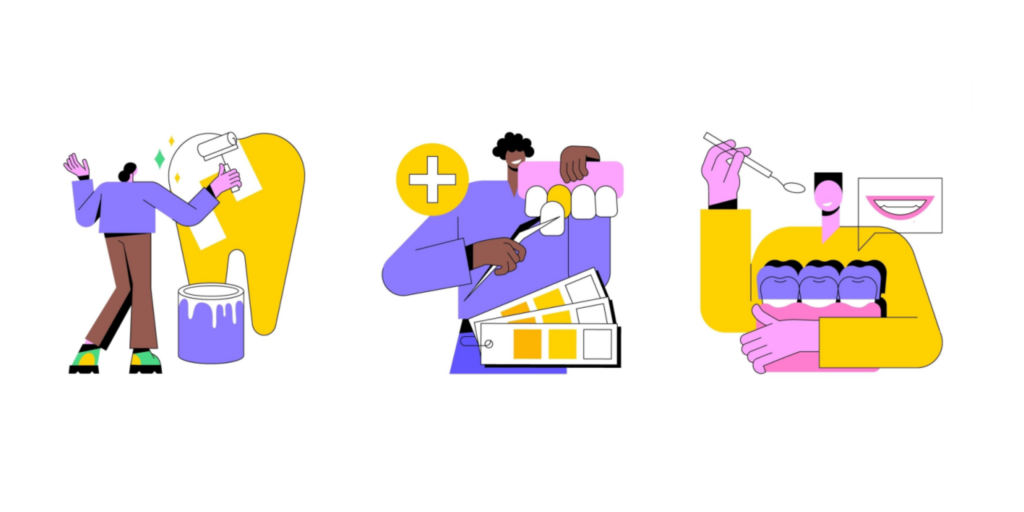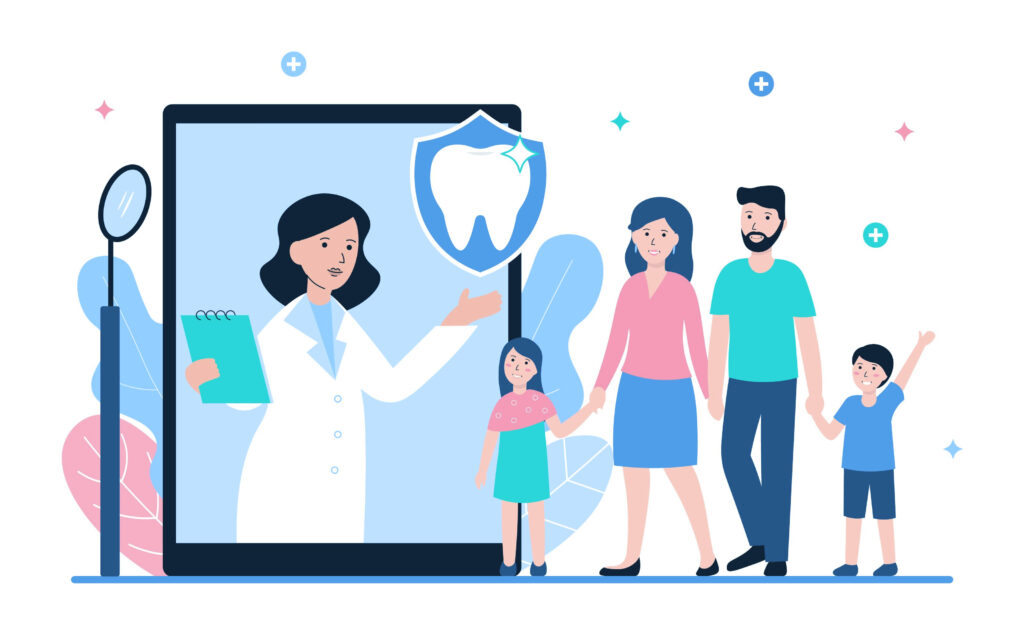Last updated on March 24th, 2021 at 03:00 pm
 Most dentists would be happy to see more new patients. It’s the solution we focus on for practice growth. More new patients means more production, right?
Most dentists would be happy to see more new patients. It’s the solution we focus on for practice growth. More new patients means more production, right?
In general terms, this is correct. But I’ve also seen new patient centric focus go horribly wrong. Between joining HMOs and other heavily discounted insurance plans, running Groupon specials, or any other means of offering unsustainably cheap or free services… some offices end up feeling like a hamster on a wheel. They put in a ton of effort and get extraordinarily busy — only to wind up with a bunch of canceled appointments, “shoppers,” and people who came in for nothing more than the “special” discount.
So yes, of course you should get more new patients, but let’s look at how to do it sustainably from a business perspective.
(Related: Dental Marketing 101, Part 1)
The Average Cost & Value of a New Patient
Let’s start with a couple of numbers. While these can vary depending on a number of factors, here are a few “national” averages:
The average new patient is worth about $1,200 to a dental practice in their first year.
 From year two forward, they’ll spend about $400 a year and stay in the practice for about 10 years. So total value for years 2-10 is $3,600
From year two forward, they’ll spend about $400 a year and stay in the practice for about 10 years. So total value for years 2-10 is $3,600
Average total lifetime value: $4,800
And when a dentist engages in marketing to attract new patients, they spend an average of $250-350 per new patient.
Average cost to acquire a new patient: $250-350
(Related: How to Turn Emergency New Patients into Great Long Term Patients)
When you look at those raw numbers, it makes sense. But you don’t practice in a theoretical average world. You practice in your office, and as I said before, there are several factors that will influence these figures for your office.
And besides, at MGE we are NOT about doing the average!
So How Can You Tilt These Numbers in Your Favor?
As an aside, this article covers a few points we show you how to improve in the MGE New Patient Workshop – specifically 1) How to get more high-quality new patients, 2) How to lower your cost for getting these new patients through effective marketing and referral programs, and 3) How to increase the value of your new patients to the practice through retention strategies and improved treatment acceptance.
Obviously, this all starts with marketing on the right channels to attract the right people to your practice. There are marketing companies out there that can help you do this, although sorting through the morass of charlatans and scam-artists that often pose as dental marketers can be daunting. So of course, the first thing we cover is how to do this effectively and how to monitor your own marketing campaigns so you’re not totally dependent on a marketing company you hire.
But this is called the “NEW PATIENT Workshop” and not the “DENTAL MARKETING Workshop” for a reason. It’s because some of the biggest factors in practice growth and increasing your bottom line have nothing to do with your marketing. They have to do with what happens after the patient calls your practice to schedule their appointment.
(Related: The Top 4 Reasons You’re NOT Getting New Patients)
How to Increase the “Value per New Patient.”
With these numbers above as a baseline. Let’s look at the three factors that will raise (or lower if you do them wrong) your average “value per new patient.”
-
Patient Retention & Recall
Dentists can slowly throttle their practice by focusing exclusively on new patient marketing and ignoring recall. It’s crazy to try to build a practice on new patients who come in once and then leave. Doctors who live off of new patients only are basically starting a new practice every month.
These patients should be retained in a recall program. And if you haven’t been adding hygiene days over the years – or worse, if you don’t have a recall program – then you are losing patients. Not only does this lower their lifetime value, but it goes against your purpose as a dentist; you’re here to help people get and stay healthy from an oral perspective, and hygiene is the whole “stay healthy” portion of that equation.
only does this lower their lifetime value, but it goes against your purpose as a dentist; you’re here to help people get and stay healthy from an oral perspective, and hygiene is the whole “stay healthy” portion of that equation.
(Related: Jumpstart Your Hygiene Department)
And this problem of patient retention is a much bigger issue than most dentists realize.
Personally, I think the statement that the “average” patient stays with a practice for 10 years can be very misleading. In fact, the very definition of an “active” patient that we’re given in the industry is misleading.
We’re told that an active patient is someone who’s been into the practice within the last 1.5-2 years. While this number may work from a practice valuation perspective, it’s not a very good number for you to work with in operating your practice.
After all, how often is a patient supposed to see the dentist? Every 3, 4 or 6 months. If you ask this question to any person off the street, they’ll tell you “twice a year” at least.
(Related: Patient Outreach: How to Get Your Patients to Answer the Phone)
What percentage of your patients have been into your office within the last 6 months? Pull a report from your practice management software. It’s enlightening!
In many cases, we find that this number is down around 10-20% of their patients (or worse) actively on a recall schedule. This means to one degree or another, they’re losing 80-90% of their patients.
My advice is: make hygiene a priority for your patients and your staff!
At the New Patient Workshop, we provide you with effective strategies to retain new patients and also reactivate overdue patients.
(Related: How I Added 9 Days of Hygiene in Less than 2 Years)
-
Referrals
We’ve all heard it. “The best patients are referrals.” Word-of-mouth is the cheapest and most effective marketing method. But it usually doesn’t get focused on. Big mistake!
Think of it like this:
The average new patient spends $4,800 over time.
The average person has an intimate connection with three people via their household or close family: 3 immediate referrals
Total new patient value including referrals: $19,200.
By encouraging the referrals and ensuring you treat the whole family, you’ve now quadrupled the value of each new patient – without increasing your marketing cost!
(Related: New Patient Referrals: 5 Ways to Get More in 2021)
And if you’re really good, each of those three people typically has at least one additional close friend or family member they can refer, making a total of 6 potential referrals and a total of $33,600!
And remember that other number about the average cost to GET a new patient of $250-$300? Well, if you spend $300 to get a new patient and that person refers you someone else – you’ve just lowered your acquisition cost to $150. If they refer you three friends you’re down to $75 each!
So, obviously referrals should be a big focus in your office. But I know how it goes – it feels “cheesy” to ask for referrals, and even though you tell your staff to do it, it falls by the wayside. You may have even tried a referral program of some kind in your office that didn’t exactly get the “buzz” you were expecting.
(Related: 5 Ways to Improve the Patient Experience)
But don’t quit! Ask your patients who their family members see. Let them know that your mission is to help the whole community get healthier, so let you know if they have any family or friends that could come into the office. You’d love to see them.
The video below shows you how to ask for referrals in a way that doesn’t feel cheesy and gets results.
And at the MGE New Patient Workshop, we give you a simple but effective program your team can use to skyrocket referrals.
And here’s another interesting fact that’s been proven time and time again: patients who accept and do their full treatment plans (not just the bare minimum that insurance covers) refer more people to your practice!
(Related: How to Create First-Class Customer Service in a Dental Office)
It’s just a fact. People who are getting healthy are more likely to refer. And this leads me into my next point:
-
Case Acceptance
I saved the most important one for last. I say it’s the most important because:
- Patients who accept more treatment are more likely to refer,
- Patients who do their full treatment plan and get healthy are happier with the office and therefore more likely to stay and show up for their recall appointment, and
- This is the most direct way to raise the dollar value per patient. By improving case acceptance, you can go from an average of $5,000 to $7,000-$8,000 or more per new patient.

I’m not talking about “over-diagnosing” or looking at the patient like a dollar symbol. I’m talking about diagnosing and presenting the complete treatment that a patient needs to get healthy, and then doing it – not just settling for what the insurance covers.
(Related: 3 Tips to Boost Case Acceptance)
When you do that, the revenues increase. It’s just an indicator that you’re really helping your patients.
It can be daunting to present a large treatment plan to a new patient. They don’t know you yet. What are they going to think if you tell them they need thousands of dollars of treatment on the first visit? They’re going to run, right? They’ll think you’re a used car salesman, right?
Actually, no. They won’t run away, if you and your team have done a good job of forming a relationship with that patient and educating them on why they need the treatment.
At the MGE New Patient Workshop, we show you how to deliver fantastic customer service from the first time the patient calls the office through the exam and treatment presentation. We also show you tools for the treatment presentation and financial arrangements so that you can connect with the patient and they understand the value of the treatment – not just the cost associated with it.
(Related: 3 Case Acceptance Killers)
But until then, I encourage you to watch this video from Dr. Winteregg and do the “challenge” that he gives you here with your new patients, and see what happens:
[embedyt] https://www.youtube.com/watch?v=nMb4YCHJEYE[/embedyt]
BONUS TIP: Training your front desk to answer the phones:
Our friends at Viva Concepts did a very interesting study. They evaluated 10,000 offices and found that the average front desk only converts 23% of callers into new patient appointment.
This means that the average office is wasting 77% of their marketing budget! I’ve seen plenty of offices double their new patients (and slash their cost to acquire a new patient in half) simply by training their front desk to answer the phone and schedule new patients properly.
[embedyt] https://www.youtube.com/watch?v=5D8bhwVPLy8[/embedyt]
(Related: How Your Hygienist Can Help Increase Case Acceptance)
So put a focus on front desk training. Listen to some phone calls. Do some practice sessions to help them get comfortable handling different types of phone calls.
At the MGE New Patient Workshop we provide training on exactly how to field questions about prices, insurance, etc., in a way that results in the patient scheduling and showing up for their appointment. We also have front desk training on our online training platform at www.ddssuccess.com.
Those are my tips for increasing the value of new patients in your practice. I hope it helps!



No Comments
Be the first to start a conversation